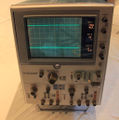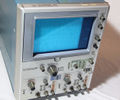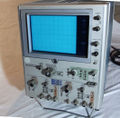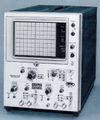5030: Difference between revisions
No edit summary |
mNo edit summary |
||
| Line 20: | Line 20: | ||
The 5030s feature differential inputs on both channels, with additional inputs for 125-turn probes ([[P6021]] or [[P6019]]). Input ranges are similar to the contemporary [[3A9]] diff/current amplifier plugin but without the variable bandwidth and DC offset controls. The horizontal deflection system is shared. | The 5030s feature differential inputs on both channels, with additional inputs for 125-turn probes ([[P6021]] or [[P6019]]). Input ranges are similar to the contemporary [[3A9]] diff/current amplifier plugin but without the variable bandwidth and DC offset controls. The horizontal deflection system is shared. | ||
The 5031/5030 include a readout system which uses small lightbulb/fiber dot matrix displays external to the CRT, similar to that in the [[576]] curve tracer. Unlike the [[576]] the | The 5031/5030 include a readout system which uses small lightbulb/fiber dot matrix displays external to the CRT, similar to that in the [[576]] curve tracer. Unlike in the [[576]], the twelve [[150-0048-01|lamps]] required for each deflection factor sub-display are driven directly with cam switches. Only the first and last steps on the time/div and volts/div switches are labelled on the front panel. | ||
{{BeginSpecs}} | {{BeginSpecs}} | ||
Revision as of 13:26, 17 March 2023
The Tektronix 5030 is a dual-beam oscilloscope that was introduced in 1969 (no longer listed in the 1973 catalog). There is a portable benchtop model, the 5030, and a rack-mount version, the R5030. The sister model 5031/R5031 is an almost identical (analog) storage scope.
The 5030s feature differential inputs on both channels, with additional inputs for 125-turn probes (P6021 or P6019). Input ranges are similar to the contemporary 3A9 diff/current amplifier plugin but without the variable bandwidth and DC offset controls. The horizontal deflection system is shared.
The 5031/5030 include a readout system which uses small lightbulb/fiber dot matrix displays external to the CRT, similar to that in the 576 curve tracer. Unlike in the 576, the twelve lamps required for each deflection factor sub-display are driven directly with cam switches. Only the first and last steps on the time/div and volts/div switches are labelled on the front panel.
Key Specifications
| Bandwidth | DC to 1 MHz (5 kHz limit switchable) |
|---|---|
| Deflection | 10 μV/Div to 10 V/Div or 1 mA/Div to 200 mA/Div (1—2—5) |
| Noise | < 15 μV / 200 μA |
| Input impedance | 1 MΩ // 50 pF |
| Time base | 1 μs/Div to 5 s/Div (1–2–5), magnifier up to ×50 |
| CMRR | 100,000:1 to 100 kHz |
| X input | 20 mV/Div to 500 mV/Div on Ext Horizontal, or Channel 2 in X-Y mode |
| CRT | 8 × 10 Div @ 1.27 cm (0.5"), P31 phosphor |
| Acceleration voltage | 4 kV |
Links
Pictures
-
-
-
-
-
-
-
-
-
-
-
-
5030 (catalog image)
-
R5030
-
Display detail (5031)
-
Detail of fiberoptic readout module
-
-
-
-
Schematics
-
Sweep schematic
Custom ICs used in the 5030
| Page | Model | Part nos | Description | Designers | Used in |
|---|---|---|---|---|---|
| 155-0028-00 | M018 | 155-0028-00 • 155-0028-01 • 155-0042-00 • 155-0042-01 • 155-0042-02 • 155-0042-03 | Miller integrator and delay pickoff | Joe Burger | 5030 • R5030 • 5031 • R5031 • 1401 • 1401A • 1480 • 1481 • 1482 • 1485 • 26G1 • 26G2 • 26G3 • 314 • 335 • 432 • 434 • 4701 • 5B10N • 5B12N • 5B31 • 5B40 • 5B42 • 5S14N • 7B52 • 7B53A • 7B53N • 7L12 • 7L13 • 7L14 • 7L18 • 7S14 • AN/USM-281C • RG501 • Telequipment D63 • Telequipment DM63 |
| 155-0029-01 | 155-0029-00,155-0029-01 | 155-0029-01 | Trigger | 26G1 • 26G2 • 26G3 • 4701 • 5030 • R5030 • 5031 • R5031 • 5B10N |



















